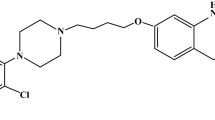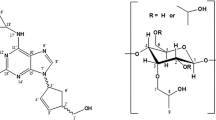Abstract
The application of different cyclodextrins (CDs) as NMR chiral solvating agents (CSAs) for the sodium salts of the proton-pump inhibitors omeprazole, pantoprazole (sesquihydrate) and rabeprazole was investigated. It was proved that the formation of diastereomeric host–guest complexes in D2O solution between the CDs and those substrates permitted the direct 1H NMR discrimination of the enantiomers of the sodium salts of these compounds without the need of previous working-up. Rotating frame nuclear overhauser effect spectroscopy (ROESY) was used to ascertain the solution geometries of the host–guest complexes. The results suggested a preferential binding of the benzimidazole moiety of the guest molecules within the macrocyclic cavity of α-CD, whereas the higher dimensions of β- and γ-CD also permitted the inclusion of the highly substituted pyridine moieties. Moreover, the solution stoichiometries and the binding constants of the complexes formed with pantoprazole at room temperature were determined by 1H and 19F NMR titration. Diffusion-filtered Spectroscopy was applied to obtain clean spectra without the interference of the HOD signal.













Similar content being viewed by others
Notes
The measured pDs of freshly prepared solutions were in all cases around 10.
H-16 signal (for the α- and β-CD complexes) and H-4 signal (for the γ-CD complex) were found to give the best linear fits (the squares of correlation coefficients, R2, were equal to 0.9988, 0.9892 and 0.9980 respectively).
References
Claramunt, R.M., López, C., Alkorta, I., Elguero, J., Yang, R., Schulman, S.: The tautomerism of Omeprazole in solution: a 1H and 13C NMR study. Magn. Reson. Chem. 42, 712–714 (2004)
Lindberg, P., Brändström, A., Wallmark, B., Mattsson, H., Rikner, L., Hoffman, K.J.: Omeprazole: the first proton pump inhibitor. Med. Res. Rev. 10, 1–54 (1990)
Shi, S., Klotz, U.: Proton pump inhibitors: an update of their clinical use and pharmacokinetics. Eur. J. Clin. Pharmacol. 64, 935–951 (2008)
Olbe, L., Carlsson, E., Lindberg, P.: A proton-pump inhibitor expedition: the case histories of omeprazole and esomeprazole. Nat. Rev. Drug Discov. 2, 132–139 (2003)
Andersson, T., Weidolf, L.: Stereoselective disposition of proton pump inhibitors. Clin. Drug Investig. 28, 263–279 (2008)
Anon.: Development of new stereoisomeric drugs. Food and Drug Administration. http://www.fda.gov/Drugs/GuidanceComplianceRegulatoryInformation/Guidances/ucm122883.htm. Accessed 5 September 2011
Branch, S.: International regulation of chiral drugs. In: Subramanian, G. (ed.) Chiral Separation Techniques. A Practical Approach, pp. 319–342. Wiley-VCH, Weinheim (2001)
Weisman, G.R.: Nuclear magnetic resonance analysis using chiral solvating agents. Asymm. Synth. 1, 153–171 (1983)
Wenzel, T.J.: Lanthanide chiral solvating agent couples as chiral NMR shift reagents. Trends Org. Chem. 8, 51–64 (2000)
Yamaguchi, S.: Nuclear magnetic resonance analysis using chiral derivatives. Asymm. Synth. 1, 125–152 (1983)
Wenzel, T.J., Wilcox, J.D.: Chiral reagents for the determination of enantiomeric excess and absolute configuration using NMR spectroscopy. Chirality 15, 256–270 (2003)
Courtieu, J., Lesot, P., Meddour, A., Merlet, D., Aroulanda, C.: Chiral liquid crystal NMR: a tool for enantiomeric analysis. In: Grant, D.M., Harris, R. (eds.) Encyclopedia of Nuclear Magnetic Resonance, pp. 497–505. Wiley, New York (2002)
Sugiura, M., Kimura, A., Fujiwara, H.: Discrimination of enantiomers by means of NMR spectroscopy using chiral liquid crystalline solution: application to triazole fungicides, uniconazole and diniconazole. Magn. Reson. Chem. 44, 121–126 (2006)
Greatbanks, D., Pickford, R.: Cyclodextrins as chiral complexing agents in water, and their application to optical purity measurements. Magn. Reson. Chem. 25, 208–215 (1987)
Redondo, J., Blázquez, M.A., Torrens, A.: Chiral discrimination of the analgesic cizolirtine by using cyclodextrins: a 1H NMR study on the solution structures of their host-guest complexes. Chirality 11, 694–700 (1999)
Szejtli, J.: Introduction and general overview of cyclodextrin chemistry. Chem. Rev. 98, 1743–1753 (1998)
Cserhati, T.: Cyclodextrins in HPLC. Encyclopedia of Chromatography, vol. 1, 3rd edn., pp. 546–556 (2010)
Cserhati, T.: Cyclodextrins in GC. Encyclopedia of Chromatography, vol. 1, 3rd edn., pp. 536–545 (2010)
Chankvetadze, B.: Chiral compounds: separation by CE and MEKC with cyclodextrins. Encyclopedia of Chromatography, vol. 1, 3rd edn, pp. 419–424 (2010)
Thunhorst, M., Holzgrabe, U.: Utilizing NMR spectroscopy for assessing drug enantiomeric composition. Magn. Reson. Chem. 36, 211–216 (1998)
Cirilli, R., Ferretti, R., Gallinella, B., De Santis, E., Zanitti, L., La Torre, F.: High-performance liquid chromatography enantioseparation of proton pump inhibitors using the immobilized amylose-based Chiralpak IA chiral stationary phase in normal-phase, polar organic and reversed-phase conditions. J. Chromatogr. A 1177, 105–113 (2008)
Berzas-Nevado, J.J., Castaneda-Penalvo, G., Rodríguez-Dorado, R.M.: Method development and validation for the separation and determination of omeprazole enantiomers in pharmaceutical preparations by capillary electrophoresis. Anal. Chim. Acta 533, 127–133 (2005)
Toribio, L., Alonso, C., del Nozal, M.J., Bernal, J.L., Jiménez, J.J.: Enantiomeric separation of chiral sulfoxides by supercritical fluid chromatography. J. Sep. Sci. 29, 1363–1372 (2006)
Figueiras, A., Sarraguça, J.M.G., Carvalho, R.A., Pais, A.A.C.C., Veiga, F.J.B.: Interaction of omeprazole with a methylated derivative of β-cyclodextrin: phase solubility, NMR spectroscopy and molecular simulation. Pharm. Res. 24, 377–389 (2007)
Redondo, J., Capdevila, A., Latorre, I.: Use of (S)-BINOL as NMR chiral solvating agent for the enantiodiscrimination of omeprazole and its analogs. Chirality 22, 472 (2010)
Coppi, L., Berenguer, R.: Method for obtaining derivatives of [[substituted-pyridyl)methyl]thio]benzimidazole, useful as intermediates for omeprazole and related antiulcer agents. PCT Int. Appl. WO 2001079194 A1
Berenguer, R., Campón, J., Coppi, L.: Method for oxidizing a thioether group into a sulfoxide group in benzimidazole derivatives. PCT Int. Appl. WO 2001068594 A1
Coppi, L., Berenguer, R., Gasanz, Y., Medrano, J.: Process for the preparation of optically active derivatives of 2-(2-pyridylmethylsulfinyl)-benzimidazole via inclusion complex with 1,1′-binaphthalene-2,2′-diol. PCT Int. Appl. WO 2006094904 A1
Anon.: Esomeprazole magnesium trihydrate monograph. European Pharmacopoeia 6th edition 2009 (http://online.pheur.org/entry.htm)
Esturau, N., Espinosa, J.F.: Optimization of diffusion-filtered NMR experiments for selective suppression of residual nondeuterated solvent and water signals from 1H NMR spectra of organic compounds. J. Org. Chem. 71, 4103–4110 (2006)
Figueiras, A., Sarraguça, J.M.G., Pais, A.A.C.C., Veiga, F.J.B., Carvalho, R.A.: New insight into the discrimination between omeprazole enantiomers by cyclodextrins in aqueous solution. J. Incl. Phenom. Macrocycl. Chem. 62, 345–351 (2008)
Braga, S.S., Ribeiro-Claro, P., Pillinger, M., Gonçalves, I.S., Fernandes, A.C., Pereira, F., Romao, C.C., Correa, P.B., Teixeira-Dias, J.J.C.: Interactions of omeprazole and precursors with β-cyclodextrin host molecules. J. Incl. Phenom. Macrocycl. Chem. 47, 47–52 (2003)
Scott, R.L.: Some comments on the Benesi Hildebrand equation. Rec. Trav. Chim. 75, 787 (1956)
Author information
Authors and Affiliations
Corresponding author
Electronic supplementary material
Below is the link to the electronic supplementary material.
Rights and permissions
About this article
Cite this article
Redondo, J., Capdevila, A., Latorre, I. et al. Host–guest complexation of omeprazole, pantoprazole and rabeprazole sodium salts with cyclodextrins: an NMR study on solution structures and enantiodiscrimination power. J Incl Phenom Macrocycl Chem 73, 225–236 (2012). https://doi.org/10.1007/s10847-011-0046-z
Received:
Accepted:
Published:
Issue Date:
DOI: https://doi.org/10.1007/s10847-011-0046-z




